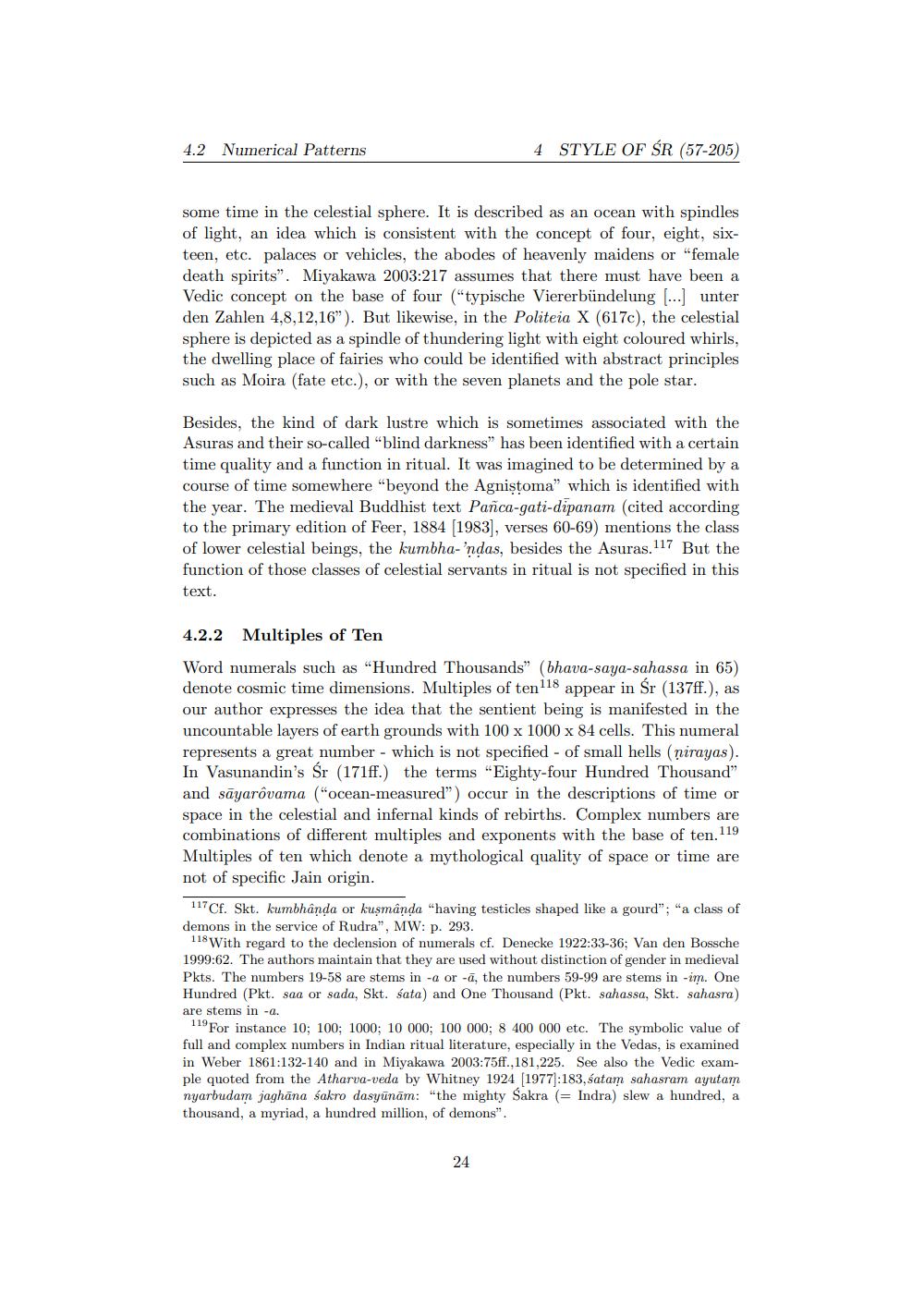________________
4.2 Numerical Patterns
4 STYLE OF ŚR (57-205)
some time in the celestial sphere. It is described as an ocean with spindles of light, an idea which is consistent with the concept of four, eight, sixteen, etc. palaces or vehicles, the abodes of heavenly maidens or "female death spirits". Miyakawa 2003:217 assumes that there must have been a Vedic concept on the base of four ("typische Viererbündelung [...] unter den Zahlen 4,8,12,16"). But likewise, in the Politeia X (617c), the celestial sphere is depicted as a spindle of thundering light with eight coloured whirls, the dwelling place of fairies who could be identified with abstract principles such as Moira (fate etc.), or with the seven planets and the pole star.
Besides, the kind of dark lustre which is sometimes associated with the Asuras and their so-called "blind darkness" has been identified with a certain time quality and a function in ritual. It was imagined to be determined by a course of time somewhere "beyond the Agnistoma" which is identified with the year. The medieval Buddhist text Pañca-gati-dipanam (cited according to the primary edition of Feer, 1884 [1983], verses 60-69) mentions the class of lower celestial beings, the kumbha-'ndas, besides the Asuras. 117 But the function of those classes of celestial servants in ritual is not specified in this text.
4.2.2
Multiples of Ten
Word numerals such as "Hundred Thousands" (bhava-saya-sahassa in 65) denote cosmic time dimensions. Multiples of ten118 appear in Śr (137ff.), as our author expresses the idea that the sentient being is manifested in the uncountable layers of earth grounds with 100 x 1000 x 84 cells. This numeral represents a great number - which is not specified - of small hells (nirayas). In Vasunandin's Śr (171ff.) the terms "Eighty-four Hundred Thousand" and sayarôvama ("ocean-measured") occur in the descriptions of time or space in the celestial and infernal kinds of rebirths. Complex numbers are combinations of different multiples and exponents with the base of ten. 119 Multiples of ten which denote a mythological quality of space or time are not of specific Jain origin.
117 Cf. Skt. kumbhanda or kuşmânda "having testicles shaped like a gourd"; "a class of demons in the service of Rudra", MW: p. 293.
118 With regard to the declension of numerals cf. Denecke 1922:33-36; Van den Bossche 1999:62. The authors maintain that they are used without distinction of gender in medieval Pkts. The numbers 19-58 are stems in -a or -a, the numbers 59-99 are stems in -im. One Hundred (Pkt. saa or sada, Skt. sata) and One Thousand (Pkt. sahassa, Skt. sahasra) are stems in -a.
119 For instance 10; 100; 1000; 10 000; 100 000; 8 400 000 etc. The symbolic value of full and complex numbers in Indian ritual literature, especially in the Vedas, is examined in Weber 1861:132-140 and in Miyakawa 2003:75ff.,181,225. See also the Vedic example quoted from the Atharva-veda by Whitney 1924 [1977]:183, satam sahasram ayutam nyarbudam jaghana śakro dasyūnām: "the mighty Sakra (= Indra) slew a hundred, a thousand, a myriad, a hundred million, of demons".
24




